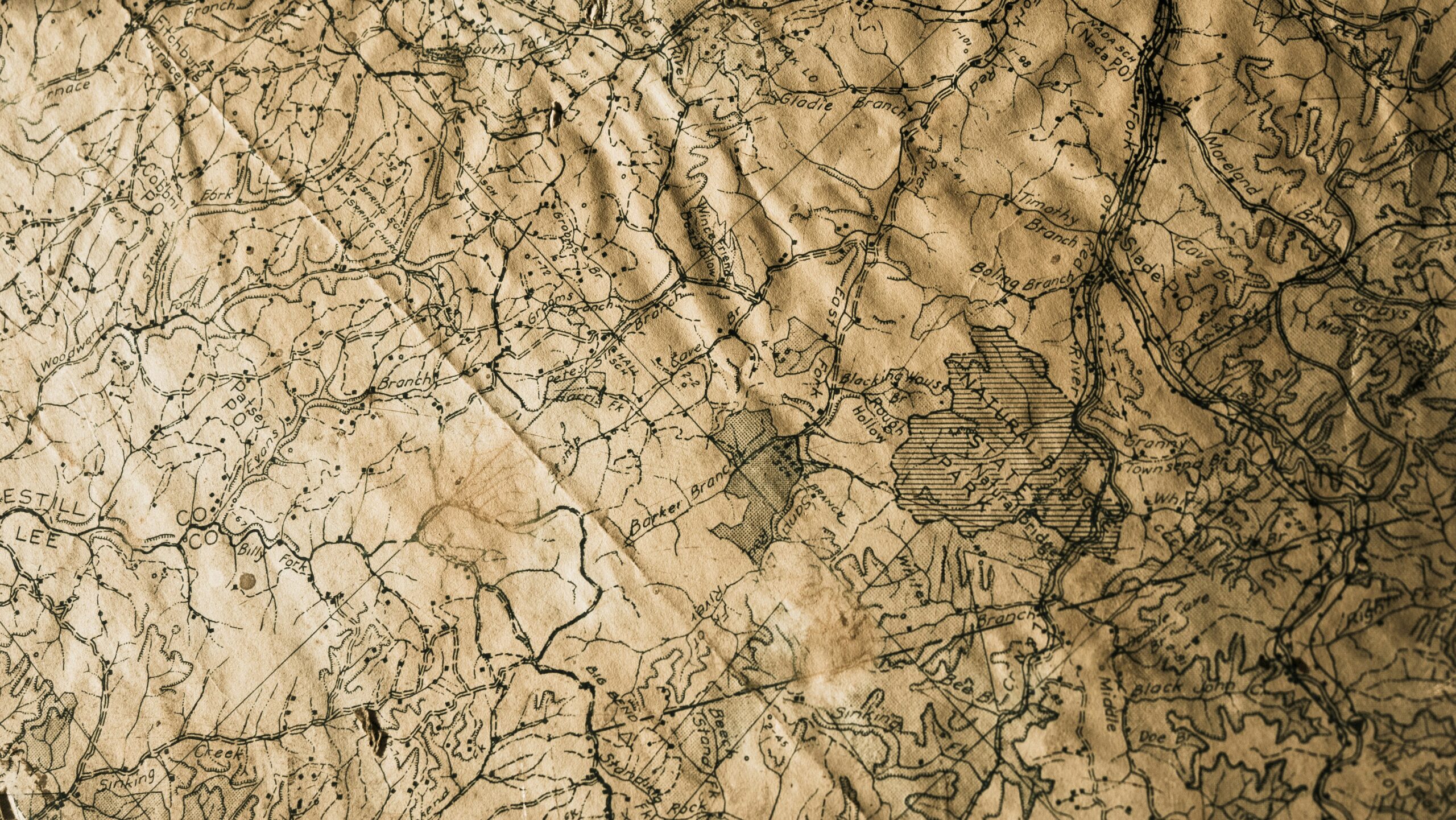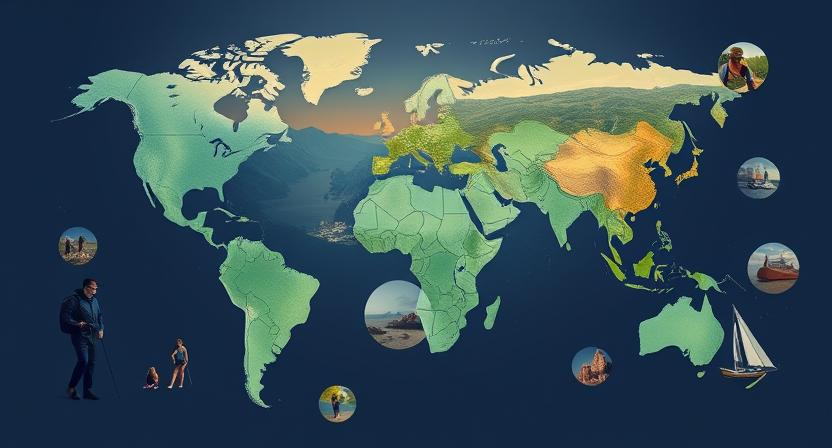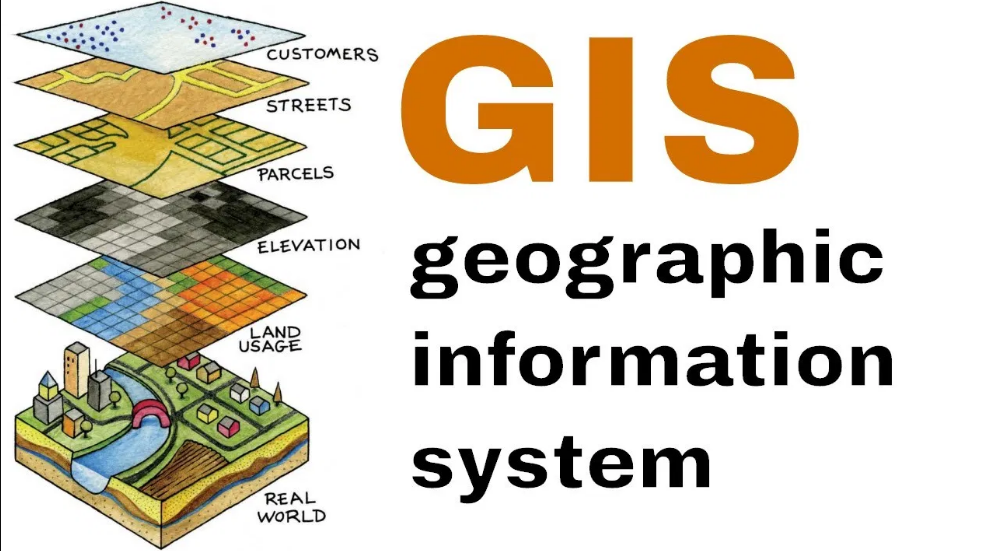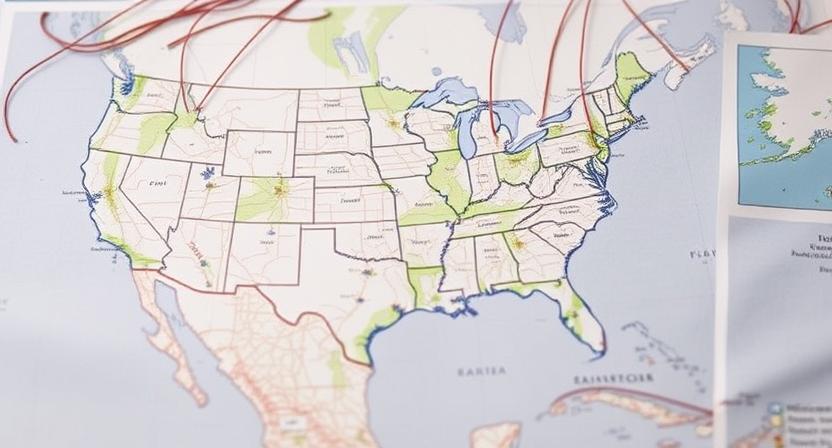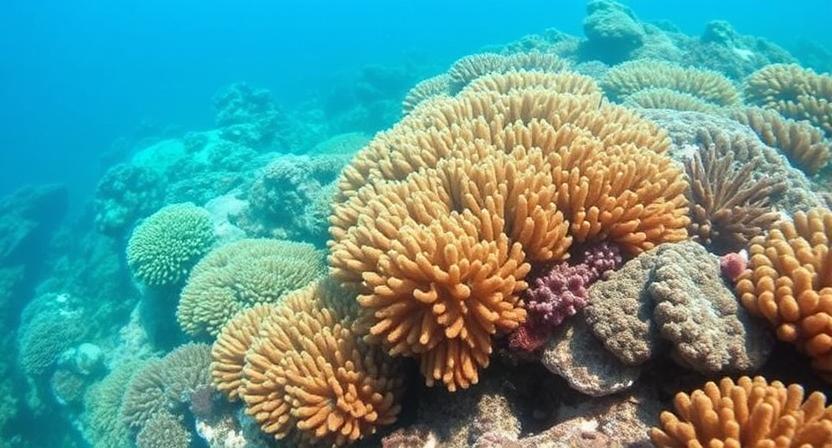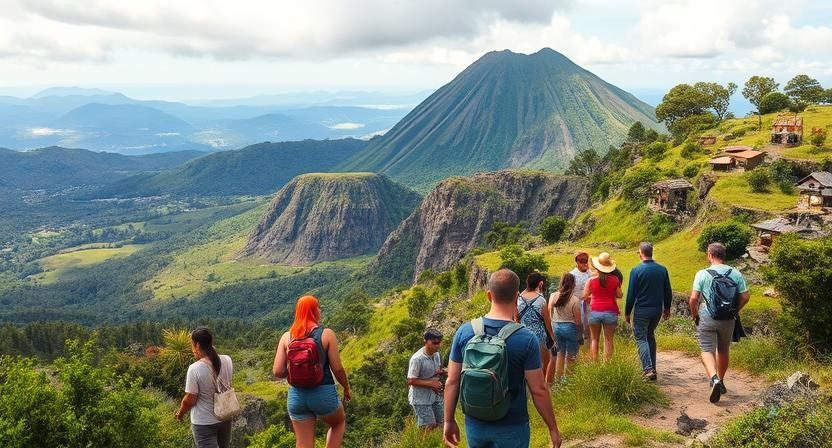
Key Factors Driving Geotourism Growth

Geotourism is experiencing a surge in popularity due to a combination of factors. The increasing interest in sustainable travel practices and responsible tourism has led to a growing demand for unique and authentic travel experiences. Geotourism, with its focus on promoting the geological and cultural heritage of a destination, appeals to travelers seeking meaningful interactions with local communities and environments. Additionally, the rise of social media and digital platforms has made it easier for geotourism initiatives to reach a wider audience, raising awareness about the importance of preserving natural and cultural treasures.
Furthermore, government support and collaboration with local communities have played a significant role in driving the growth of geotourism. Many countries and regions are recognizing the economic benefits of geotourism and are investing in infrastructure development and promotion to attract visitors. By working closely with stakeholders, including indigenous communities and conservation groups, destinations can ensure that the unique geodiversity and cultural heritage of an area are protected and celebrated through sustainable tourism practices.
• Government support and collaboration with local communities
• Increasing interest in sustainable travel practices
• Rise of social media and digital platforms
• Growing demand for unique and authentic travel experiences
Benefits of Geotourism for Local Communities
Geotourism can bring about numerous benefits for local communities, acting as a catalyst for economic growth and job creation. By attracting tourists interested in geological features and landscapes, geotourism destinations can experience an increase in revenue from accommodation, dining, and souvenir sales. This influx of tourists not only boosts the local economy but also encourages entrepreneurship and the development of small businesses within the community.
Moreover, geotourism has the potential to foster a sense of pride and appreciation for the natural and cultural heritage of an area among residents. Through engagement with tourists and sharing their knowledge about the local geology and history, community members can develop a stronger connection to their surroundings and a better understanding of the importance of preserving these assets for future generations. This cultural exchange can lead to increased cultural awareness and mutual respect between locals and visitors, contributing to a more harmonious coexistence within the community.
• Geotourism can boost local economy through increased revenue from accommodation, dining, and souvenir sales
• Encourages entrepreneurship and development of small businesses within the community
• Fosters a sense of pride and appreciation for natural and cultural heritage among residents
• Strengthens connection to surroundings and understanding of importance of preservation for future generations
• Promotes cultural exchange leading to increased cultural awareness and mutual respect between locals and visitors
Environmental Impacts of Geotourism
Geotourism, while offering a unique way for visitors to connect with nature and geological wonders, can also have various environmental impacts. The influx of tourists to fragile ecosystems or sensitive areas can lead to habitat disruption, soil erosion, and pollution. Increased human activity, if not properly managed, can threaten the biodiversity and natural balance of these regions. It is essential for geotourism operators and policymakers to implement sustainable practices to minimize these negative effects and preserve the ecological integrity of the destinations.
Additionally, the construction of infrastructure to support geotourism, such as roads, trails, and facilities, can alter the landscape and disrupt local wildlife habitats. Unregulated tourist activities like off-road driving, littering, or disturbance of wildlife can further degrade the environment. Without careful planning and monitoring, the cumulative impact of geotourism can degrade the very attractions that draw visitors in the first place. Sustainable management practices and responsible visitor behavior are crucial in mitigating these environmental impacts and ensuring the long-term sustainability of geotourism destinations.
• Geotourism can lead to habitat disruption, soil erosion, and pollution
• Increased human activity can threaten biodiversity and natural balance
• Sustainable practices are essential to minimize negative effects and preserve ecological integrity
• Infrastructure construction for geotourism can alter landscapes and disrupt wildlife habitats
• Unregulated tourist activities like off-road driving, littering, or disturbance of wildlife can further degrade the environment
• Careful planning and monitoring are necessary to prevent degradation of attractions.
Cultural Preservation Through Geotourism
Geotourism plays a crucial role in cultural preservation by promoting the appreciation and understanding of diverse cultural heritage sites. Through geotourism initiatives, local communities are able to showcase their unique traditions, stories, and customs to visitors from around the world. By integrating cultural elements into tourism experiences, geotourism helps in preserving and revitalizing traditional practices that might be at risk of fading away.
Furthermore, cultural preservation through geotourism fosters a sense of pride and ownership among local communities towards their heritage. Visitors engaging with local cultural activities and immersing themselves in the traditions of a place contribute to the preservation of intangible cultural assets. As a result, geotourism not only safeguards cultural heritage but also creates opportunities for cultural exchange and dialogue between tourists and residents, enriching the overall travel experience.
• Geotourism promotes appreciation and understanding of diverse cultural heritage sites
• Local communities showcase unique traditions, stories, and customs to visitors
• Integrating cultural elements into tourism experiences helps preserve traditional practices
• Fosters a sense of pride and ownership among local communities towards their heritage
• Visitors engaging with local cultural activities contribute to the preservation of intangible cultural assets
• Creates opportunities for cultural exchange and dialogue between tourists and residents
Promoting Conservation Efforts Through Geotourism
Geotourism has emerged as a powerful tool for promoting conservation efforts in various regions around the world. By highlighting the unique geological features, natural landscapes, and cultural heritage of an area, geotourism nurtures a sense of appreciation and stewardship among visitors. Through guided tours, educational programs, and sustainable practices, geotourism encourages visitors to engage with the environment in a way that promotes conservation and protection of fragile ecosystems.
One of the key strategies in promoting conservation efforts through geotourism is fostering partnerships between local communities, tour operators, and conservation organizations. By working together, stakeholders can develop responsible tourism practices that minimize negative impacts on the environment while maximizing the benefits for both the community and the visitors. Through collaborative efforts, geotourism initiatives can effectively address conservation challenges, educate visitors about the importance of environmental protection, and contribute to the long-term sustainability of the destinations.
• Fostering partnerships between local communities, tour operators, and conservation organizations
• Developing responsible tourism practices to minimize negative impacts on the environment
• Maximizing benefits for both the community and visitors through collaborative efforts
• Addressing conservation challenges effectively through geotourism initiatives
• Educating visitors about the importance of environmental protection
• Contributing to the long-term sustainability of destinations
Case Studies of Successful Geotourism Initiatives

Geotourism initiatives have been pivotal in driving sustainable tourism practices in various regions around the world. One notable case study is the geotourism project in Iceland, which focuses on showcasing the country’s unique geology and geothermal energy sources. By emphasizing the natural wonders of Iceland, this initiative not only attracts tourists but also educates them on the importance of preserving these geological marvels for future generations.
Another successful geotourism initiative can be seen in the Azores, Portugal, where a community-led project has been instrumental in promoting the archipelago’s diverse volcanic landscapes. Through engaging local guides and promoting responsible tourism practices, this initiative has not only boosted the economy but has also fostered a sense of pride and ownership among the local population. By highlighting the geological heritage of the Azores, this geotourism initiative has effectively balanced the needs of tourists with the conservation of the environment.
• Geotourism initiatives in Iceland and the Azores have been successful in promoting sustainable tourism practices
• The geotourism project in Iceland showcases the country’s unique geology and geothermal energy sources
• The initiative educates tourists on the importance of preserving geological marvels for future generations
• In the Azores, a community-led project promotes diverse volcanic landscapes through local guides and responsible tourism practices
• This initiative has boosted the economy and fostered pride among the local population by highlighting geological heritage
Challenges Faced by Geotourism Industry
Geotourism, despite its numerous benefits, faces significant challenges in today’s tourism landscape. One key issue is the delicate balance between promoting tourism activities and preserving the environment and cultural heritage of a destination. Oftentimes, the rapid influx of tourists can lead to overexploitation of natural resources, degradation of local landscapes, and disruption of traditional ways of life for indigenous communities.
Additionally, the lack of strong regulations and enforcement mechanisms in some geotourism destinations poses a challenge in ensuring sustainable practices. Without clear guidelines and monitoring systems in place, there is a risk of unchecked development, which can have detrimental effects on the ecological and cultural integrity of a region. Furthermore, the challenge of striking a balance between economic growth from tourism and the need for conservation efforts remains a constant struggle in geotourism development.
• The delicate balance between promoting tourism activities and preserving the environment and cultural heritage
• Rapid influx of tourists leading to overexploitation of natural resources
• Lack of strong regulations and enforcement mechanisms in some geotourism destinations
• Risk of unchecked development without clear guidelines and monitoring systems
• Struggle to balance economic growth from tourism with conservation efforts
Importance of Sustainable Practices in Geotourism
To ensure the longevity and integrity of geotourism destinations, sustainable practices play a crucial role in balancing the needs of visitors with the preservation of natural and cultural heritage. By adopting sustainable principles, such as reducing carbon footprints, promoting local sourcing, and minimizing waste generation, geotourism can thrive without compromising the environment. Implementing sustainable practices not only safeguards the ecological and cultural significance of destinations but also enhances the overall visitor experience by offering authentic and responsible travel opportunities.
Moreover, integrating sustainable practices into geotourism operations fosters a sense of community stewardship and responsibility towards the conservation of natural resources. By involving local communities in decision-making processes and promoting environmental awareness through educational initiatives, geotourism initiatives can empower residents to actively participate in sustainable development practices. This collaborative approach not only enhances the socio-economic well-being of communities but also reinforces the importance of preserving the unique characteristics that attract tourists to geotourism destinations.
• Reducing carbon footprints
• Promoting local sourcing
• Minimizing waste generation
Furthermore, sustainable practices in geotourism help to mitigate negative impacts on the environment and cultural heritage. By implementing measures such as water conservation, energy efficiency, and responsible waste management, geotourism destinations can minimize their ecological footprint and protect fragile ecosystems. These practices also contribute to the preservation of historical sites and indigenous traditions, ensuring that future generations can continue to enjoy these unique attractions.
In addition, sustainable geotourism practices have a positive impact on the overall economy by creating employment opportunities and supporting local businesses. By prioritizing partnerships with small-scale enterprises and promoting fair trade practices, geotourism initiatives can stimulate economic growth while preserving the authenticity of cultural experiences. This not only benefits local communities but also fosters a sense of pride and ownership among residents who are actively involved in promoting sustainable tourism practices.
Overall, embracing sustainable principles in geotourism is essential for maintaining the balance between environmental conservation, cultural preservation, and socio-economic development. By prioritizing sustainability in all aspects of operations – from transportation to accommodation to visitor activities – geotourism destinations can create a lasting legacy that benefits both present-day visitors and future generations.
Role of Geotourism in Biodiversity Conservation
Geotourism plays a significant role in biodiversity conservation by raising awareness among visitors about the importance of preserving fragile ecosystems. Through guided tours and educational programs, geotourism initiatives highlight the rich diversity of flora and fauna in natural habitats, emphasizing the need for sustainable practices to protect these species and their habitats. By showcasing the value of biodiversity to tourists, geotourism contributes to fostering a sense of responsibility and stewardship towards the environment.
Moreover, geotourism encourages active participation in conservation efforts by engaging tourists in wildlife monitoring, habitat restoration projects, and sustainable resource management practices. By involving visitors in hands-on activities that directly contribute to preserving biodiversity, geotourism not only enhances the overall visitor experience but also empowers individuals to make a positive impact on the environment. This collaborative approach fosters a sense of connection and commitment to conservation goals, creating a more sustainable future for biodiversity conservation.
• Geotourism raises awareness about the importance of preserving fragile ecosystems
• Guided tours and educational programs highlight the rich diversity of flora and fauna in natural habitats
• Emphasizes the need for sustainable practices to protect species and their habitats
• Showcases the value of biodiversity to tourists, fostering a sense of responsibility towards the environment
• Engages tourists in wildlife monitoring, habitat restoration projects, and sustainable resource management practices
• Hands-on activities directly contribute to preserving biodiversity
• Enhances visitor experience and empowers individuals to make a positive impact on the environment
• Collaborative approach fosters connection and commitment to conservation goals
Economic Opportunities Created by Geotourism
Geotourism presents a range of economic opportunities for local communities, particularly in regions with unique geological features or cultural heritage sites. By attracting tourists interested in experiencing the natural and cultural assets of a destination, geotourism can stimulate the growth of various industries such as hospitality, transportation, and handicrafts. This influx of tourist spending not only creates job opportunities for residents but also encourages the development of local businesses and infrastructure.
Furthermore, the promotion of geotourism can lead to increased investment in conservation and sustainable development projects within a region. As visitors engage with the natural and cultural heritage of an area, they develop a greater appreciation for the importance of preserving these assets for future generations. This heightened awareness can result in funding towards environmental protection initiatives, community-based tourism projects, and educational programs, contributing to the long-term economic and environmental sustainability of the region.
• Geotourism stimulates growth in industries such as hospitality, transportation, and handicrafts
• Tourist spending creates job opportunities for residents
• Encourages development of local businesses and infrastructure
• Promotion of geotourism leads to increased investment in conservation and sustainable development projects
• Visitors develop greater appreciation for preserving natural and cultural heritage
• Funding towards environmental protection initiatives, community-based tourism projects, and educational programs contributes to long-term economic and environmental sustainability
Community Engagement in Geotourism Development

Community engagement plays a vital role in the development of geotourism initiatives. By involving local residents, businesses, and organizations in the planning and decision-making processes, geotourism projects can better reflect the needs and values of the community. This engagement fosters a sense of ownership and pride among locals, leading to more sustainable and successful tourism activities that benefit both visitors and residents.
Furthermore, involving the community in geotourism development can help build relationships and partnerships that are essential for the long-term success of these initiatives. By harnessing local knowledge and expertise, geotourism projects can be designed in a way that respects and preserves the cultural and environmental heritage of the area, creating authentic and meaningful experiences for tourists. This collaborative approach not only enhances the overall quality of geotourism offerings but also ensures that economic benefits are shared among all stakeholders involved.
• Engaging local residents, businesses, and organizations in planning geotourism projects
• Fostering a sense of ownership and pride among community members
• Building relationships and partnerships for long-term success
• Harnessing local knowledge and expertise to preserve cultural and environmental heritage
• Creating authentic and meaningful experiences for tourists
• Sharing economic benefits among all stakeholders involved
Incorporating Indigenous Knowledge in Geotourism
Indigenous knowledge holds a wealth of wisdom and understanding about the landscapes, ecosystems, and cultural heritage that geotourists are eager to explore. By integrating indigenous perspectives into geotourism initiatives, local communities can showcase their deep connection to the land and share valuable insights into sustainable practices that have been passed down through generations. This collaboration not only enriches the tourism experience for visitors but also fosters a sense of pride and empowerment among indigenous communities as they play a key role in guiding and shaping the narrative of their own heritage.
Highlighting the indigenous knowledge embedded in geotourism not only adds authenticity and depth to the visitor experience but also serves as a platform for preserving and promoting traditional practices that are at risk of being lost over time. Through storytelling, traditional ceremonies, and guided tours led by indigenous guides, tourists can gain a deeper appreciation for the rich cultural tapestry of the destinations they visit. By recognizing and respecting the invaluable contributions of indigenous communities to geotourism, we can ensure that these voices are heard and their heritage is celebrated and safeguarded for future generations to cherish.
• Indigenous knowledge offers valuable insights into sustainable practices
• Collaboration enriches tourism experience for visitors and empowers indigenous communities
• Highlighting indigenous knowledge adds authenticity and depth to visitor experience
• Platform for preserving and promoting traditional practices at risk of being lost over time
• Through storytelling, ceremonies, and guided tours, tourists gain appreciation for cultural heritage
• Recognizing contributions of indigenous communities ensures voices are heard and heritage is celebrated
Educational Value of Geotourism Experiences
Geotourism experiences offer a unique educational value by allowing visitors to delve into the geological wonders of a destination. Through guided tours, interpretation centers, and interactive activities, tourists can deepen their understanding of how natural processes shaped the landscapes they are exploring. By learning about the formation of rocks, landforms, and minerals, visitors gain a newfound appreciation for the earth’s history and the forces that continue to shape it.
Moreover, geotourism experiences not only focus on the geological aspects but also highlight the cultural and historical significance of a place. By immersing themselves in the local traditions, folklore, and customs, tourists can gain insights into the connections between the land and its people. This interdisciplinary approach to education fosters a holistic understanding of the destination, encouraging visitors to respect and preserve its natural and cultural heritage for future generations.
• Geotourism experiences offer a unique educational value by allowing visitors to delve into the geological wonders of a destination.
• Through guided tours, interpretation centers, and interactive activities, tourists can deepen their understanding of how natural processes shaped the landscapes they are exploring.
• By learning about the formation of rocks, landforms, and minerals, visitors gain a newfound appreciation for the earth’s history and the forces that continue to shape it.
• Geotourism experiences not only focus on the geological aspects but also highlight the cultural and historical significance of a place.
• By immersing themselves in local traditions, folklore, and customs, tourists can gain insights into the connections between the land and its people.
• This interdisciplinary approach to education fosters a holistic understanding of the destination.
Balancing Tourist Needs with Environmental Protection
Tourism is a significant economic driver for many destinations, attracting visitors with promises of unique experiences and breathtaking landscapes. However, the influx of tourists can place immense pressure on the environment, leading to issues such as habitat degradation, pollution, and strain on natural resources. Balancing the needs and desires of tourists with the imperative of environmental protection is essential to ensure the long-term sustainability of tourism activities.
In order to strike this delicate balance, it is crucial for destinations to implement responsible tourism practices. This includes promoting sustainable transportation options, establishing carrying capacity limits for popular sites, and educating visitors about the importance of minimizing their environmental footprint. By fostering a culture of environmental stewardship among tourists and local communities alike, destinations can create a harmonious coexistence between tourism activities and the preservation of natural ecosystems.
• Promoting sustainable transportation options
• Establishing carrying capacity limits for popular sites
• Educating visitors about minimizing their environmental footprint
By implementing these responsible tourism practices, destinations can mitigate the negative impacts of tourism on the environment while still providing memorable experiences for visitors. It is essential for stakeholders in the tourism industry to work together towards finding innovative solutions that prioritize both economic growth and environmental conservation. Through collaborative efforts and a commitment to sustainability, we can ensure that future generations will be able to enjoy the beauty of our natural world.
Collaboration Between Stakeholders in Geotourism
Collaboration between stakeholders in geotourism is essential for the successful development and management of sustainable tourism initiatives. When government bodies, local communities, tour operators, conservation organizations, and research institutions work together, they can leverage their unique strengths and resources to create positive outcomes for both the environment and the local economy. By fostering open communication and cooperation among diverse stakeholders, geotourism projects can be designed to minimize negative impacts on natural and cultural resources while maximizing the benefits for all involved parties.
In many cases, the collaboration between stakeholders in geotourism goes beyond just the initial planning stages. Continued engagement throughout the implementation and monitoring phases ensures that the objectives of the project are being met in a way that is inclusive and transparent. By sharing knowledge, expertise, and responsibilities, stakeholders can address challenges proactively and adapt to changing circumstances effectively. This collaborative approach not only enhances the overall success of geotourism initiatives but also strengthens relationships between diverse groups, fostering a sense of shared ownership and commitment to long-term sustainability.
• Collaboration between stakeholders in geotourism is essential for successful development and management of sustainable tourism initiatives
• Government bodies, local communities, tour operators, conservation organizations, and research institutions can leverage their unique strengths and resources through collaboration
• Open communication and cooperation among diverse stakeholders help minimize negative impacts on natural and cultural resources while maximizing benefits for all involved parties
• Continued engagement throughout implementation and monitoring phases ensures objectives are met inclusively and transparently
• Sharing knowledge, expertise, and responsibilities allows stakeholders to address challenges proactively and adapt effectively
• Collaborative approach enhances overall success of geotourism initiatives while strengthening relationships between diverse groups
Empowering Local Communities Through Geotourism

Empowering local communities through geotourism is a significant aspect of sustainable tourism development. By actively involving residents in the planning and management of tourism activities, geotourism initiatives can help generate employment opportunities, improve infrastructure, and foster a sense of pride and ownership among community members. Through capacity-building initiatives and training programs, local residents can develop skills to actively participate in the tourism sector, creating a more inclusive and equitable industry that benefits all stakeholders.
Furthermore, geotourism can empower local communities by preserving and promoting their cultural heritage and traditional knowledge. By showcasing indigenous practices, crafts, and traditions, geotourism provides a platform for communities to share their unique stories and identities with visitors. This cultural exchange not only enriches the tourist experience but also helps local communities retain their cultural heritage and pass down traditional knowledge to future generations, ensuring the preservation of their identity and values.
• Geotourism involves residents in planning and management of tourism activities
• Generates employment opportunities and improves infrastructure
• Fosters a sense of pride and ownership among community members
• Capacity-building initiatives and training programs help develop skills for participation in the tourism sector
Furthermore, geotourism plays a crucial role in preserving and promoting cultural heritage and traditional knowledge within local communities. By showcasing indigenous practices, crafts, and traditions, geotourism provides a platform for communities to share their unique stories with visitors. This cultural exchange not only enhances the tourist experience but also helps preserve cultural heritage for future generations. It ensures that traditional knowledge is passed down, maintaining the identity and values of these communities over time.
Overall, empowering local communities through geotourism creates a more sustainable tourism industry that benefits both residents and visitors alike. By involving locals in decision-making processes, preserving cultural heritage, and fostering economic growth through tourism activities, geotourism can contribute to long-term prosperity while respecting the environment and enhancing social well-being within these communities.
Measuring the Success of Geotourism Initiatives
Evaluating the impact and success of geotourism initiatives is crucial in understanding their effectiveness in achieving set goals. One common method of measuring success is through visitor numbers and revenue generated from geotourism activities. An increase in these metrics can indicate a growing interest in the destination and the overall positive economic impact of geotourism.
Additionally, assessing the level of community involvement and empowerment resulting from geotourism initiatives is key to measuring success. Monitoring the extent to which local communities have benefited from geotourism projects, such as job creation, infrastructure development, and cultural preservation, can provide valuable insights into the social sustainability of these initiatives.
• Visitor numbers and revenue generated are key indicators of success in geotourism initiatives
• Increase in these metrics can show growing interest in the destination and positive economic impact
• Assessing community involvement and empowerment is crucial for measuring success
• Monitoring benefits to local communities like job creation, infrastructure development, and cultural preservation provides insights into social sustainability
Future Trends in Geotourism Development
As geotourism continues to evolve, future trends indicate a greater emphasis on sustainable practices and responsible travel. Travelers are increasingly seeking authentic and meaningful experiences that contribute positively to local communities and the environment. This trend is driving the development of geotourism initiatives that focus on preserving cultural heritage, promoting conservation efforts, and supporting biodiversity conservation.
Another key trend in geotourism development is the integration of technology to enhance visitor experiences and raise awareness about the importance of environmental conservation. From interactive mobile apps that provide educational information about geological sites to virtual reality experiences that allow travelers to explore fragile ecosystems without physically impacting them, technology is playing a crucial role in shaping the future of geotourism. Additionally, the use of social media and online platforms is helping to connect geotourists with local communities, creating opportunities for cultural exchange and mutual learning.
– Greater emphasis on sustainable practices and responsible travel
– Preservation of cultural heritage
– Promotion of conservation efforts
– Support for biodiversity conservation
– Integration of technology to enhance visitor experiences
– Use of interactive mobile apps for educational information about geological sites
– Virtual reality experiences to explore fragile ecosystems without physical impact
– Utilization of social media and online platforms to connect geotourists with local communities
– Creation of opportunities for cultural exchange and mutual learning
Integrating Technology in Geotourism Promotion
Technology plays a crucial role in shaping the way geotourism destinations are promoted to audiences worldwide. Through the use of social media platforms, websites, and mobile applications, geotourism initiatives can reach a broader demographic, enticing travelers to explore unique geological and cultural sites. Virtual reality experiences and interactive maps enable potential visitors to engage with destinations before physically embarking on their journeys, sparking interest and curiosity.
By integrating technology in geotourism promotion, stakeholders can provide real-time updates on conservation efforts, weather conditions, and special events happening at these destinations. Utilizing geotagging and geolocation features, tourists can easily navigate through unfamiliar terrains, enhancing their overall experience while minimizing environmental impact. Technology also facilitates online booking systems, making it convenient for visitors to arrange accommodations, tours, and activities, fostering a seamless travel experience from planning to execution.
• Social media platforms, websites, and mobile applications play a crucial role in promoting geotourism destinations
• Virtual reality experiences and interactive maps engage potential visitors before their journeys
• Real-time updates on conservation efforts, weather conditions, and special events are provided through technology integration
• Geotagging and geolocation features help tourists navigate unfamiliar terrains easily
• Online booking systems make it convenient for visitors to arrange accommodations, tours, and activities
Addressing Overtourism Through Geotourism Strategies
As the global tourism industry continues to expand, certain destinations are facing the negative consequences of overtourism, where the sheer volume of visitors is straining local resources and disrupting the natural and cultural environment. Geotourism presents a strategic approach to address this issue by promoting responsible travel practices that focus on the conservation of a location’s distinct character, heritage, and environment. By encouraging tourists to engage with the unique geology, biodiversity, and culture of a destination in a sustainable manner, geotourism can help alleviate the pressures of overtourism.
Through the implementation of geotourism strategies, destinations can shift the focus from quantity to quality, aiming to attract visitors who are genuinely interested in understanding and preserving the natural and cultural aspects of a place. By emphasizing education, community involvement, and the protection of local ecosystems, geotourism helps to disperse tourist activities more evenly, reducing congestion in popular spots and encouraging the exploration of lesser-known attractions. By fostering a deeper appreciation for the intricacies of a destination, geotourism not only safeguards the environment but also enhances the overall visitor experience, creating a more sustainable and fulfilling form of tourism.
• Geotourism promotes responsible travel practices focused on conservation
• Encourages engagement with unique geology, biodiversity, and culture in a sustainable manner
• Shifts focus from quantity to quality of visitors
• Emphasizes education, community involvement, and protection of local ecosystems
• Helps disperse tourist activities evenly and reduce congestion in popular spots
• Encourages exploration of lesser-known attractions
• Fosters appreciation for destination intricacies
• Safeguards the environment and enhances visitor experience

